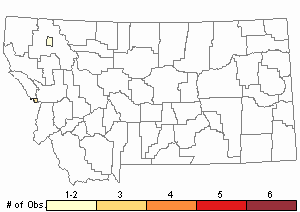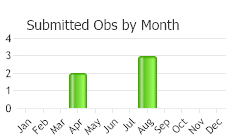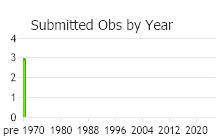View in other NatureServe Network Field Guides
NatureServe
Montana
Utah
Wyoming
Idaho
Wisconsin
British Columbia
South Carolina
Yukon
California
New York
An Isothecium Moss - Isothecium myosuroides
General Description
Plants: Pleurocarpous (Vitt 1988), growing in “dense, pendent wefts,” somewhat yellow to deep green, and moderately shiny (FNA 2014). Main stems prostrate (Smith 1980) with stipe short or wanting, the secondary stems 20-40 mm in length (FNA 2014), upright, somewhat tree-like to prostrate and erratically branched (Smith 1980), the branches occasionally a little crowded and bowing downward; long, tapering branches often present, their leaves smaller and more slender; hyalodermis wanting; paraphyllia wanting; pseudoparaphyllia leaf-like, occasionally dentate; stems radiculose (FNA 2014).
Leaves: Main stem leaves widely deltoid or sometimes more slenderly so, the leaf tip occasionally thin and tapering narrowly, the leaf edges almost smooth, and the costa sometimes lacking. Branch leaves egg-shaped to lance-shaped with ovate tendencies, the edges dentate all over and more conspicuously so in the apiculus, the costa sometimes reaching 2/3 of the way up the leaf (FNA 2014).
Leaf Cells: Alar cells of the main stem leaf hardly distinct, the alar area small. Alar area of the branch leaves well-delineated and occasionally suddenly concave. Medial cells of the lamina longer than 5:1 (FNA 2014).
Diagnostic Characteristics
The closely related Isothecium stoloniferum is highly variable and has a morphotype that is frequently indistinguishable from Isothecium myosuroides (FNA 2014).
Range Comments
North American Range
Canada: NL, NS and PEI; USA: AK, TN and NC, NH and ME (FNA 2014). Known in Montana from Flathead, Glacier, Lake, Lincoln, and Missoula Counties (Elliott and Pipp 2016).
Observations in Montana Natural Heritage Program Database
Number of Observations: 5
(Click on the following maps and charts to see full sized version)
Map Help and Descriptions
Relative Density

Recency


 (Observations spanning multiple months or years are excluded from time charts)
(Observations spanning multiple months or years are excluded from time charts)
Habitat
Stones and boulders, bluffs, bottoms of trees, shaded habitats in woods. Occurring from lowlands to mid-elevations (FNA 2014).
Reproductive Characteristics
Sporophytes uncommon. Seta smooth, russet, 10-20 mm tall. Capsule sometimes reaching 1.5 mm in length; operculum cone-shaped; peristome with both exostome and endostome, yellow; exostome processes with exterior transverse ridges below and papillae above. Calyptra draping hood-like (FNA 2014).
Stewardship Responsibility
References
- Literature Cited AboveLegend:
 View Online Publication
View Online Publication Elliott, J.C. and A.K. Pipp. 2018. A Checklist of Montana Mosses (1880-2018). Updated 3 January, 2020. Montana Natural Heritage Program, Helena, Montana. 73 pp.
Elliott, J.C. and A.K. Pipp. 2018. A Checklist of Montana Mosses (1880-2018). Updated 3 January, 2020. Montana Natural Heritage Program, Helena, Montana. 73 pp. Flora of North America Editorial Committee, eds. 2014. Flora of North America North of Mexico. Volume 28. Bryophytes: Mosses, Part 2. Oxford University Press, Inc., NY. xxi + 702 pp.
Flora of North America Editorial Committee, eds. 2014. Flora of North America North of Mexico. Volume 28. Bryophytes: Mosses, Part 2. Oxford University Press, Inc., NY. xxi + 702 pp. Smith, A.J.E. 1980. The Moss Flora of Britain and Ireland. Cambridge University Press, Cambridge. 705 pp.
Smith, A.J.E. 1980. The Moss Flora of Britain and Ireland. Cambridge University Press, Cambridge. 705 pp. Vitt, D. J. Marsh, and R. Bovey. 1988. Mosses, Lichens & Ferns of Northwest North America. Seattle, WA: University of Washington Press. 296 p.
Vitt, D. J. Marsh, and R. Bovey. 1988. Mosses, Lichens & Ferns of Northwest North America. Seattle, WA: University of Washington Press. 296 p.
- Additional ReferencesLegend:
 View Online Publication
View Online Publication
Do you know of a citation we're missing? Elliot, J. C. 1993. Second checklist of Montana mosses. Unpublished report. U.S. Forest Service, Region 1. Missoula, MT. 45 pp.
Elliot, J. C. 1993. Second checklist of Montana mosses. Unpublished report. U.S. Forest Service, Region 1. Missoula, MT. 45 pp. Lawton, E. 1971. Keys for the Identification of the Mosses on the Pacific Northwest. Reprinted from 'Moss Flora of the Pacific Northwest'. Published as Supplement No. 2 of the Journal of the Hattori Botanical Laboratory. Nichinan, Miyazaki, Japan. 66 pp.
Lawton, E. 1971. Keys for the Identification of the Mosses on the Pacific Northwest. Reprinted from 'Moss Flora of the Pacific Northwest'. Published as Supplement No. 2 of the Journal of the Hattori Botanical Laboratory. Nichinan, Miyazaki, Japan. 66 pp. Lawton, E. 1971. Moss Flora of the Pacific Northwest. Hattori Botanical Laboratory. Japan: Yamabuki-cho, Shinjuku-ku, Tokyo. 362 pages plus appendices.
Lawton, E. 1971. Moss Flora of the Pacific Northwest. Hattori Botanical Laboratory. Japan: Yamabuki-cho, Shinjuku-ku, Tokyo. 362 pages plus appendices. Malcolm, B., N. Malcolm, J. Shevock, and D. Norris. 2009. California Mosses. Nelson, New Zealand: Micro-Optics Press. 430 pp.
Malcolm, B., N. Malcolm, J. Shevock, and D. Norris. 2009. California Mosses. Nelson, New Zealand: Micro-Optics Press. 430 pp.
- Web Search Engines for Articles on "An Isothecium Moss"





